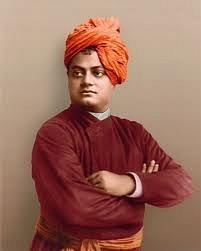
Complete Works of Swami Vivekananda
This post was earlier published by me at http://tinyurl.com/6wynhxl
1893, Chicago, The World Parliament of Religions –
A young monk from India, dressed in orange robes, stood up to address the gathering. He bowed nervously to Saraswati, the Goddess of Learning, and started with “Sisters and Brothers of America”. The 7000 strong audience, stood up to a man, and gave him a standing ovation for 3 minutes. None had ever spoken to them like before. When he finished his speech, the people in the gathering rushed over to congratulate him. For the first time, Hinduism, was not seen as an exotic Oriental oddity, but as a philosophy with immense depth, from which the West could learn. The man was Swami Vivekananda .
My introduction to Vivekananda was through my grandmother. She had lost her husband and her eldest son( my father’s brother) around the same time. In order to get over the trauma, she had joined the Ramakrishna Mission , and became actively involved in it’s activities. Growing up with her, she often narrated many tales of Ramakrishna Paramahamsa and Swami Vivekananda to me. While I was too young to comprehend the philosophy, I was still captivated by some of the events in his life. There was the story of his courage, when a sailor was injured, and he alone tended to him, when others ran away. There was the story of his unwillingness to take things at face value, when he climbed a reportedly haunted tree, to prove that no spirits existed there. His large heartedness in not sending people empty handed away from his place.
But most of all the image of Swami Vivekananda , standing hands folded, with the turban, would be something that I would carry all m life with him. The face radiated a glow, a sort of conviction, that comes from deep within. I was inspired by his most famous quote “ Arise, Awake and stop not, till you reach your goal”. As I grew older, I admired this man more for his beliefs, his character and his conviction. I had been to most of the places, associated with his life, his birth place at Kolkata, the Belur Math, started by him, the Rock Memorial at Kanyakumari , where he meditated, and received enlightenment. And the Ice House at Chennai( now Vivekananda Illam) , where he spent some time before leaving for US. While I had already had some knowledge of Swami Vivekananda’s life, it was his complete works which enabled me to gain more perspective on this great soul.
The Complete Works of Swami Vivekananda , is in effect a set of 9 volumes, which I received from my grandmother some time back. This entire set of works, deals with in detail his philosophy, his travels, his experiences. It took me quite some time to finish this entire set of volumes. Finished as in reading it fully. Because the philosophy and his thoughts are so deep like the ocean, you keep going in and in, but you never find the end. Every time I read one of those volumes, I feel like I have missed out something before. It’s a never ending journey, you keep going on and discovering continuously. Even if I spend my life time, reading those volumes, I can still never claim to have known it fully.
That’s because a person of Swami Vivekananda’s intellect and caliber, is born very rarely. He was not a armchair philosopher, nor is his the quick fix brand of chicken soup philosophy . His philosophy and his thoughts, were based on his experiences in India and West. He was not a drawing room philosopher, who read some Western works and then claimed to be an intellectual. This was a man who traveled the length and breadth of India. He mingled with ordinary people, slept with the masses, witnessed first hand the oppression and poverty of ordinary Indians , dined with the kings. That is why when you read his works, you find that Indianness resonating in them. And that is what makes these books a fascinating read, of how he actually drew upon real life experiences for his thoughts. And yes he did not just restrict himself to mere thoughts. He once claimed “ I hold him a traitor, who having been educated at expense of the masses, does nothing to better their status”.
He started the Ramakrishna Mission which has grown into an organization rendering yeoman service to the masses in fields of education, health and child welfare. I have been associated with this organization, and have volunteered first hand for many of their social activities. I had seen the sheer dedication of the monks to their job. I had also closely interacted with many of the senior monks, and was amazed at their immense knowledge of current affairs and the world around them. I also had the privilege of listening to one of their most prominent members, Swami Ranganathananda.